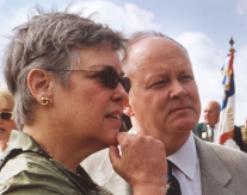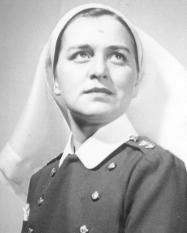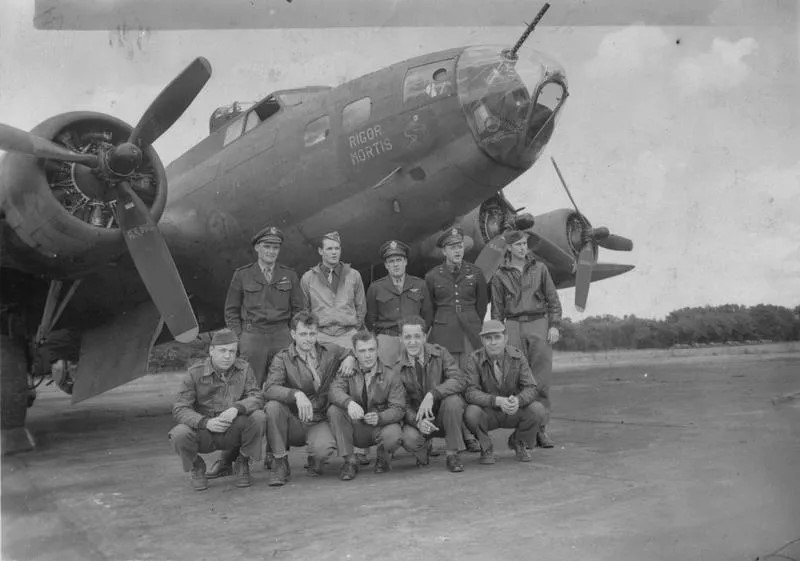|
BIOGRAPHY of WILLIAM F. MOONEY
written by his son William Mooney (Maryland) in 2004
(Translation made by Corinne Pouvreau and David Grant)
 My father, William Francis Mooney, was born in Chicago, Illinois, USA, on September 27, 1918. His father-also named William F. Mooney--was a beef trader who bought and sold cattle at the Chicago Stockyards. My father, William Francis Mooney, was born in Chicago, Illinois, USA, on September 27, 1918. His father-also named William F. Mooney--was a beef trader who bought and sold cattle at the Chicago Stockyards.
My father always wanted to be a newspaper reporter. After high school he briefly attended journalism school, but quit to become a real newsman in 1935 at the age of 17. He worked for the Chicago City News Bureau, earning $12 a week.
 When World War II began, my father felt that it was his duty to participate. In 1940-- before the United States joined the war--he enlisted in the Canadian infantry, becoming a gunner with Canada's 1st Surrey Regiment. He was sent to London, where he met his wife(and my mother)-to-be, Margaret Kate Hunt. She had been born in Montreal, Canada, and was a nurse in the Royal Canadian Army Medical Corps. When World War II began, my father felt that it was his duty to participate. In 1940-- before the United States joined the war--he enlisted in the Canadian infantry, becoming a gunner with Canada's 1st Surrey Regiment. He was sent to London, where he met his wife(and my mother)-to-be, Margaret Kate Hunt. She had been born in Montreal, Canada, and was a nurse in the Royal Canadian Army Medical Corps.
 In 1942, after the United States did enter the war, my father transferred to the U.S. Army Air Corps and became a tail gunner on B-17 bombers. The family has a photograph of him as part of the crew of the "Rigor Mortis" (#42-30678), which flew with the 305th Bomb Group - 366th Bomb Squadron. (The 305th was based in Chelveston, England.) In 1942, after the United States did enter the war, my father transferred to the U.S. Army Air Corps and became a tail gunner on B-17 bombers. The family has a photograph of him as part of the crew of the "Rigor Mortis" (#42-30678), which flew with the 305th Bomb Group - 366th Bomb Squadron. (The 305th was based in Chelveston, England.)
However, because injuries were frequent on B-17s, the crews often combined men from various aircraft. When my father was shot down on his 17th mission, he was on board the "Tangier Bloody Show." This happened on July 4, 1943, over Saint-Colomban, France. He was captured and sent to a prisoner-of-war (POW) camp. (As it happens, the "Rigor Mortis" was shot down on Feb. 25, 1944, over Germany.)
My father spent 22 months in POW camps, much of it in Stalag 17B. This camp near Krems, Austria, held prisoners from many countries, including France. It became quite famous in the United States after the war. One of the inmates, Ben H. Phelper, co-wrote "Stalag 17," a Broadway play that became a successful movie with American actor William Holden. The popular (and humorous) 1960s TV series "Hogan's Heroes" was very loosely based on the play and movie.
While he was in prison camp, my father corresponded with Margaret Hunt, who had moved to Algeria with the Canadian forces. She nursed wounded allied troops as they moved north to Monte Cassino, Italy. Eventually she returned to England.
In Stalag 17, like the other POWs, my father endured considerable hardship but maintained his spirit and independence. The prisoners attended classes on many subjects, played baseball and other sports, and put on amateur theatrical productions--all the while looking for opportunities to escape from the camp.
Food and firewood were frequently scarce. My father enjoyed telling the story of how, one cold winter night, he directed his fellow prisoners to break up the wooden furniture for fuel. A German guard demanded that they stop, but my angry and freezing father said he'd be happy to buy the barracks. The astonished guard thought about the proposition and quickly wrote up a bill of sale, payment to be made at war's end in American dollars. Unfortunately, the paperwork was lost so the Mooney family does not now own property in Austria.
As the war was ending, the Germans moved the prisoners of Stalag 17B away from the advancing Allied forces to Braunau, Austria. Then, on May 3, 1945, the prisoners were liberated by American troops.
 After his release from prison camp, my father went back to England and proposed to Margaret Hunt. The couple was married in Canada, and then moved to Chicago to start their post-war life. My father returned to the City News Bureau and the new Mrs. Mooney worked as a nurse. In 1949 my father joined a major newspaper, the Chicago Daily News, as an investigative and political reporter. After his release from prison camp, my father went back to England and proposed to Margaret Hunt. The couple was married in Canada, and then moved to Chicago to start their post-war life. My father returned to the City News Bureau and the new Mrs. Mooney worked as a nurse. In 1949 my father joined a major newspaper, the Chicago Daily News, as an investigative and political reporter.
My parents had four children-Patricia, William, Catherine, and Michael. My father spent most of his professional career as a reporter and assistant editor for the Chicago Daily News. Among his many notable stories were a series on the derelicts who lived on the fringes of society in Chicago, coverage of the trial of a former Illinois governor who was convicted of accepting bribes, and the 1963 assassination of President John F. Kennedy. He was also part of a team that exposed a senior State of Illinois employee who stole $2.5 million dollars. For this series the newspaper won a Pulitzer Prize-the most important award in American journalism. Among his many notable stories were a series on the derelicts who lived on the fringes of society in Chicago, coverage of the trial of a former Illinois governor who was convicted of accepting bribes, and the 1963 assassination of President John F. Kennedy. He was also part of a team that exposed a senior State of Illinois employee who stole $2.5 million dollars. For this series the newspaper won a Pulitzer Prize-the most important award in American journalism.
In 1978 the Daily News went out of business. My father was asked to work for the State of Illinois as an investigator. He was happy to use the skills he had gained in 40 years as a journalist to investigate corrupt and criminal employees of the State. He frequently worked on cases involving the abuse of patients in state hospitals.
In November 1984 my mother died. My father died six months later, on May 21, 1985. Remembering him, his colleagues described him as both cynical and sensitive--"tough, cocky, irreverent, street-smart, a total pro." In pursuit of a story he was honest, persistent, and aggressive. The only thing he liked as much as pursuing a good story was teaching younger reporters to become solid journalists who could carry on what he saw as some of the most important work in the world-keeping the public informed.
[Back]
|

